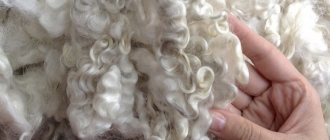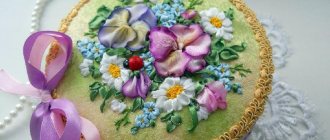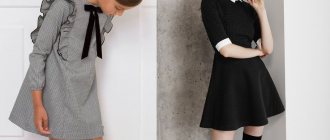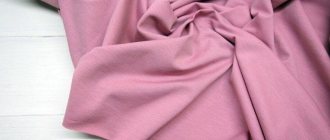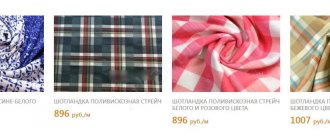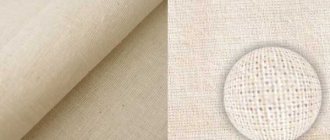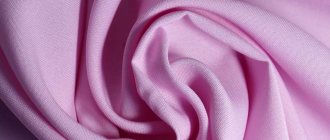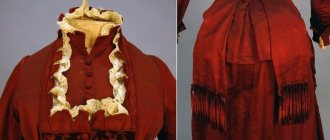A brief excursion into history
England is considered the birthplace of the fabric. Flannel first appeared in Wales in the 16th century. Initially, the basis was pure wool. It was this composition that contributed to the popularity of the material. It was considered medicinal. This was especially true for red varieties.
The Welsh had their own secrets of trade. Multi-colored canvases were highly valued. But they were not painted. During the production process, threads of different shades were intertwined in certain proportions: blue, white, red, brown, black. If it was desired to obtain light shades, dark wool fiber was bleached with sulfur dioxide.
In Russia, the new product appeared 3 centuries ago. It was brought by the reformer Tsar Peter the Great. At first, the material was appreciated by the soldiers, since at first the fabric made from sheep’s wool was used to sew foot wraps. The loose structure ensured good air exchange, and the fibers provided softness. The rough tarpaulin did not chafe their feet, and the servicemen felt quite comfortable in their boots.
In our country, the healing abilities of flannel were also appreciated. There are documented references to doctors who treated the royal family. The name of the fabric can also be found in the works of V. Dahl.
At the dawn of its appearance in England, the material was used mainly for the manufacture of sportswear. Since 1924, a new era in the life of flannel began. Business suits began to be made from it. It is associated with the Prince of Wales. For his visit to America, he chose a flannel suit. And without thinking about it, he turned clothing into a fashion trend that held a leading position in the business wardrobe until the middle of the last century. Today, the fashion for flannel suits is returning.
The English classic Jonathan Swift, who told the world about the adventures of Gulliver, also mentions the treatment of joints with soft, warm fabric. The procedure is simple: the source of inflammation was rubbed with cognac and wrapped in flannel.
A little history
England, or rather Wales - one of the most conservative regions of the British Empire of the 17th-18th centuries - is considered the birthplace of a soft, but dense and durable material - flannel. Here the local Welsh first wove heavy cloth from combed sheep's wool, which over the centuries evolved into modern flannel fabric.
Initially it was not a cheap material. In addition, it was credited with certain medicinal properties, which made the fabric even more expensive. The effectiveness of flannel in treating diseases, of course, has not been proven. Although in the book about Gulliver's adventures by the English writer Jonathan Swift there is a description of the treatment of inflamed joints, which were first rubbed with cognac and then wrapped in soft flannel.
The Welsh, who knew many secrets of fabric production, learned, among other things, to produce multi-colored fabrics from pure wool. In this case, no dyes or staining were used. Black, brown, white yarn of natural colors obtained from sheep's wool were woven together in different proportions. To obtain wool of light shades, it was bleached with sulfur dioxide.
Over time, the material appeared in other European countries and in Russia, thanks to Peter I.
Compound
“Classic” flannel is made from wool. The Welsh could not imagine any other raw material for this fabric. Today it is not only woolen, but also half-woolen. However, most often the fabric consists of cotton. Moreover, the fibers are heterogeneous, which is why the traditional brushed appearance is achieved.
The basis is medium-fine carded yarn with a thread density of 42-60%. For weft, hardware yarn is used - more voluminous. Relative fiber density 53-60%. Viscose can be added to natural raw materials. In this case, the final textile product acquires a slight shine. Synthetic fibers can also be chosen as additives.
Weaving methods are different: plain, rapeseed, twill. The latter can be recognized by the sparse fleece on both sides, through which the thread pattern is visible. By the way, the pile can be evenly distributed both on one side and on the face and back at the same time.
Types of flannel
The modern textile market offers several varieties. All of them have high performance indicators, but may differ in the technologies used in the production process.
| Species name | Description |
| Harsh | An ordinary, slightly rough-looking canvas that has not been subjected to any processing. Belongs to the category of technical fabrics. Used as napkins for wiping items. Can be used in industry. For example, in the production of musical instruments. The hammers in the piano are upholstered with flannel fabric. |
| Bleached | Subjected to bleaching at the initial stage of production. The cotton plant from which the fabric is made is not always white. Often it has other shades. To give whiteness and uniform coloring, the material is bleached. Can be used in snow-white form for sewing bedding, children's clothing, or dyed in different shades in the future. |
| Belozemelnaya | One of the varieties of bleached flannel. A drawing is applied to a perfectly white background. It can be small or large. |
| Unpaved | The second type of bleached material. It also has prints on one side. But they are not applied to a snow-white surface, but to a pre-painted one. |
| Plain painted | This kind of textile is quite common. Has a single color on both sides. A characteristic feature is that it is not the finished fabric that is dyed, but individual threads. That is why this coloring is durable, uniform, and has no sharp transitions. This variety is in demand for sewing suits, coats, and home wear. |
For both white-earth and soil varieties, dyes are usually applied to the outside. This ensures safety and allows you to choose natural fabric even for children, allergy sufferers, and people with sensitive skin. The paint does not come into contact with the skin, which means that the risk of a negative reaction (redness, rash) is minimal.
Types by application
Textile workers distinguish 2 large groups. This:
| Shirt flannel. | Characteristic features are small pile and increased density. Artificial fibers and synthetics can be added to the composition. This variety can be recognized by its prints - checkered, less often - stripes. The popularity of shirt fabric has its ups and downs. The first peak was observed a century ago - in the 20s. The material was placed on a pedestal by fans of the beat movement, led by Jack Kerouac. The second peak is the 90s of the last century. Shirts owe their increased interest to Kurt Cobain. Today, such wardrobe items are preferred by the male audience, who choose an informal style of clothing. |
| Negligent. | Is in stable demand. Its demand increases especially in the off-season and winter seasons. The name of the category is quite arbitrary. This fabric is used for sewing not only dressing gowns, but also home dresses, nightgowns, pajamas, and children's products. Warm, soft clothing warms you well and gives you comfort, a feeling of calm and relaxation. Distinctive touches are a pattern on a colored (very rarely on a white) background, high density, one-sided or double-sided combing. |
Despite the fact that it is customary to distinguish only 2 groups, other things are also sewn from flannel.
Types by density
Flannel is a fairly heavy fabric. Weight can be up to 400 g per meter. But this is not its only difference. The material is not uniform in density. There are varieties on sale with different indicators:
- light - 160 g/sq.m. meter;
- average 175-258 g/sq.m. meter;
- heavy – 270 g/sq.m. meter.
The scope of use for each group is different. Textile with a density of 270 g/m2. meter is chosen for the production of outerwear: coats, warm suits. Shirts, bathrobes, and bed linen are made from other analogues.
For reference: Production of materials is established in different countries. In Russia, canvases made in the Ivanovo region and analogues from China are popular.
According to the material
The question of what size diapers are needed for a newborn is very closely related to the material from which they will be made. After all, each fabric has its own characteristics: some are very elastic and allow the fabric to stretch, others, on the contrary, can “shrink” after washing, which means it is better to purchase them a little more than the specified standard. So be sure to take this parameter into account when purchasing.
Batiste diapers frighten many people because they are very thin and tear quickly. On the one hand, this is their disadvantage. On the other hand, it is difficult to find a more breathable and lightweight material than this. The optimal parameters for cambric canvases are 120×75.
Natural material based on cotton. The cooler is hypoallergenic, environmentally friendly, stretches well, and practically does not wrinkle. For newborns, such diapers are ideal in hot weather. There is only one drawback - this fabric shrinks a lot after washing. So don’t buy canvases smaller than 130×90.
This is an organic, unprocessed material from which disposable diapers are made. They do not need to be washed, they save time, and are sold at an affordable price. However, they are not recommended for regular swaddling. So - to go to the clinic, for example, or to visit. But they are the ones that suggest the smallest size (60×60, 70×50), which allows the use of such a cloth for premature newborns.
Calico diapers are the most popular for newborns. This is 100% cotton. They are lightweight and multifunctional. They can be used as sheets and towels. In the cold season, a chintz diaper is placed on a flannel one - the result is double warmth and softness. The optimal parameters are 120×90 and 130×90.
Knitted diapers are a new model that has gained wide popularity. They are practical and easy to use. It is placed on top of the flannel to enhance the warmth. In summer it is used as the main one. It does not constrict the body, takes on absolutely any shape, and is suitable for free swaddling, as it allows the baby to move his arms and legs. You can find the following parameters: 100×120, 120×95, 130×90.
Let's get to know each other better: main characteristics
Flannel has won the recognition of millions of consumers thanks to its performance indicators. Among them:
- High density. Depending on the composition and production method, it can vary from 160 g/sq. meter up to 270 g/sq. meter.
- Breathability. This is explained by the arrangement of the fibers in relation to each other. The structure of the fabric is loose. Therefore, air can circulate freely. This provides comfort and eliminates excessive sweating and the greenhouse effect.
- Hygroscopicity. The material absorbs moisture well, while retaining it in the fibers. The risk of irritation is reduced to zero.
- High heat saving. The spaces between the threads trap the heat generated by the human body. Therefore, it is never cold in such things.
- Hypoallergenic. Material made from natural cotton raw materials is safe even for asthmatics and allergy sufferers. But you need to be careful with wool and wool blend varieties.
Note: The sizes of cuts (their width) produced by manufacturers vary. For diapers, varieties with a width of 80-90 cm are used. For other products - 150-220 cm.
In a nutshell about a bright palette
Immediately after its appearance, flannel was associated only with light shades. The enterprising British wanted variety and discovered several ways to change colors: weaving multi-colored threads and dyeing.
Today on sale there are cuts from light (even whitish) to deep dark tones. Print lovers are not short of choice. The most common one for shirts is plaid. Among the options for men's clothing there are striped patterns. In women's and children's clothes, floral motifs, abstractions, funny emoticons, and cartoon characters often predominate.
Let's say a word about the shortcomings
Despite a wide range of advantages and a set of high performance characteristics, the delicate, pleasant fabric also has its drawbacks. These include:
- Hygroscopicity. Unfortunately, it can serve as more than just an advantage. Water molecules settle between the villi and are firmly held by them. When squeezing, there are practically no drops. The liquid evaporates naturally, and this is a long process. Therefore, flannel items take a long time to dry.
- Tendency to shrink. A disadvantage characteristic of almost all natural fabrics. It is better not to wash in hot water.
- Wrinkleability. Relevant for cotton analogues. Creases can appear on the surface very easily. But they quickly smooth out.
- Abrasion. After several washes, the lint may decrease significantly or disappear altogether. This does not apply to the patterns and the fabric itself, but you will have to say goodbye to the fibers. Tactility will not change. She will remain just as pleasant.
These shortcomings cannot be called critical. With proper care, many of them can be forgotten.
Rules of care
Flannel does not require special care. It can even be washed in hot water. High-quality material will not shrink or fade. But you should not use products that contain chlorine. It can destroy the structure of the fabric, so special gentle stain removers are used.
If you have flannel bedding, turn it inside out the first time you wash it and wash it in cold water to set the pattern. Then you can wash the textiles at 90 degrees. But when removing stains of various origins, try not to rub the problem area, because this will cause the top fleecy layer to roll off.
Now you know what kind of fabric this is - flannel. The scope of its application is truly wide, thanks to its properties: strength, softness, wear resistance. The material is great for both adult clothing and children's clothing. It is easy to care for, but can last for many years. You can also read our tips on how to remove resin from clothes in another section.
Additionally, look at: children's sizes - what are their parameters? Find out in another article.
Read also: US children's sizes to Russian (Aliexpress).
Read about the features of caring for wool, half-wool and cotton fabrics in the special section “Care”.
We read together the article “Chart of sizes for newborns” - all the parameters in one place.
Comparison with other fabrics
Flannel is sometimes confused with other materials. Some species (baika, bumazea) are considered its varieties. This is actually not true. Difficulties also arise when choosing fabrics for bed linen. Let's try to figure out what is the difference between textile varieties.
| Material name | Differences |
| Bike | Despite the numerous similarities, it is still possible to distinguish the 2 options. The bike is denser, heavier, tougher. When you touch it, you don’t feel the silkiness that is characteristic of flannel. |
| Bumazeya | Another similar analogue. But in the manufacture of boumazea, only twill weave is used. Backcombing occurs on only one surface: either the front or back. |
| Flannelette (another name is winsiette) | It is not for nothing that it has a similar name, since there are a lot of similarities. But you can still tell the difference: flannelette is heavier and does not have softness. |
| Calico | The question of choice arises when purchasing bedding. Both types have their own advantages and are essentially equivalent. The only difference is that calico can withstand much more washing cycles without losing its appearance. Over time, pellets may appear on flannel due to lint. |
| Fleece | The main difference is in the composition. This is a synthetic fabric based on polyester. |
| Microfiber | This is also synthetic. They are hygroscopic. Water flows off the surface of the microfiber. This is good for some products, but not for bedding. |
From history: It is noteworthy that for a long time the army regulations required the use of flannel foot wraps instead of socks. This rule was introduced by Peter the Great. It has operated to this day. Changes were made to the charter only in 2007.
Folding techniques
Using diapers instead of diapers is very practical. You just need to learn how to use them correctly
Kerchief. You need to take a piece of 90 x 180 cm. Place the larger side towards you.
- take the bottom corners and fold them with the top ones;
- bend the resulting rectangle in half, connecting the lower left corner to the right;
- Fold the lower left corner diagonally;
- do the same with the lower right corner;
- put the baby in the middle of the resulting “kerchief”;
- stretch the bottom edge of a hand-made diaper between the legs;
- fold the side edges alternately onto the baby’s tummy;
- tuck the ends into the middle or you can tie them, but not tightly.
The result is diaper panties that are ready for use.
Rectangular. A piece of gauze 90 x 90 cm is used.
- fold in half lengthwise;
- again in half lengthwise;
- place the short edge towards you;
- unscrew the edge;
- put the boy so that the folded edge is in front, and the girl so that the thickened edge is under the back;
- press down with panties
It is important to remember that these reusable diapers can only be used until the baby crawls and sits up. After all, the child will feel pressure in the tummy and you can forget about comfort.
Scope of application
Warm, pleasant to the touch fabric has found its place in the production of various products. They sew from it:
| Baby supplies. | Baby vests, rompers, suits, caps. But the most common are flannel diapers. Just as chintz is popular for summer, flannel is popular for winter. Sizes and prices are quite varied. The cost of diapers 120x75 cm and 120x90 cm is approximately 100-130 rubles. Analogs with dimensions 150x100 cm will be more expensive. |
| Women's outfits. | Dress (gown) fabric is used. These could be home dresses, suits, sleepwear, and underwear. |
| Men's things. | Suits, shirts. Gray trousers are highly prized. Stylists call them a universal wardrobe item, as they blend seamlessly with any shade. They can be worn with jackets, vests or just one shirt. Even the strictest dress code favors them. At the same time, they retain their individuality and allow them to stand out among other office employees. |
| Outerwear. | Jackets, coats for the entire system. Dense material retains heat well. Therefore, you will never freeze in such products. |
| Houseware. | Soft bedspreads and cozy blankets look stylish and give comfort, gentle touches, and tranquility. |
Flannel textiles are also used for technical needs. Cleaning wipes have become widespread.
